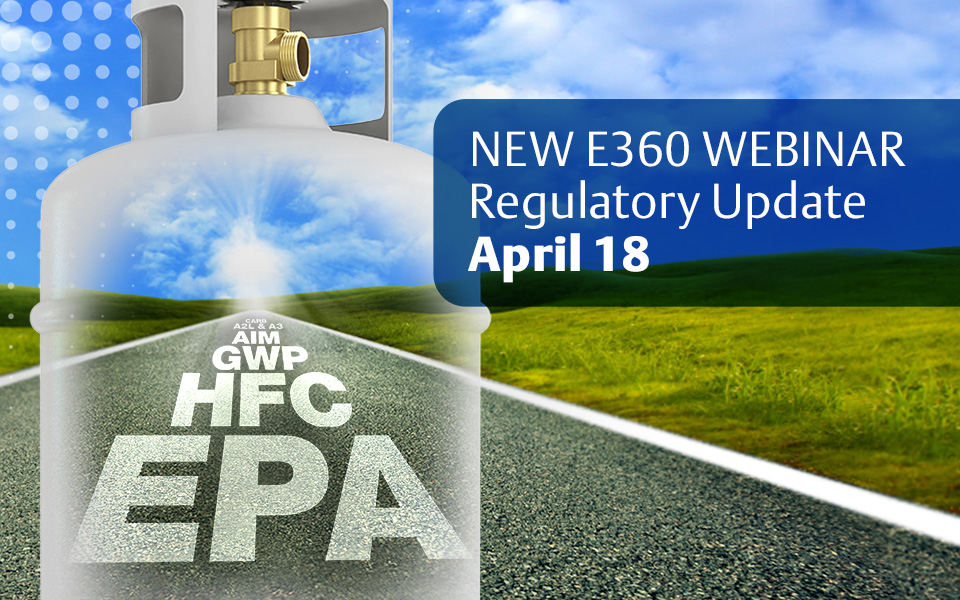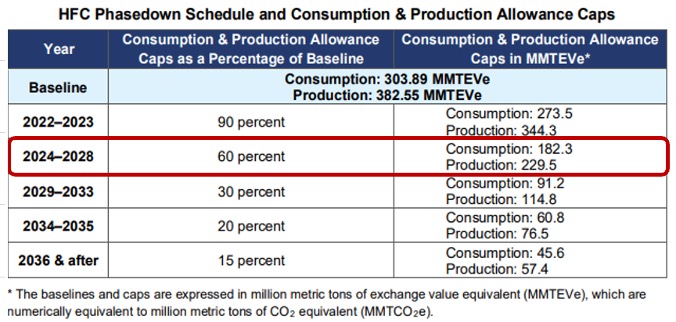*On June 1, 2023 Emerson’s Climate Technologies business became a new standalone company – Copeland. Though our name has changed, we are building on more than a century of HVACR innovation and industry leadership, and Copeland continues to offer the same products, industry stewardship, and learning opportunities you’ve grown to trust. Information found on this webpage posted before June 1, 2023 may contain our old name or branding, but you can be at ease knowing it was created with the knowledge and expertise of Copeland.
As the global hydrofluorocarbon (HFC) refrigerant phasedown continues to progress, U.S. regulations, codes and standards are evolving to support the emergence of lower-global warming potential (GWP) alternatives. Stakeholders throughout the commercial refrigeration and AC sectors are keeping a close eye on new developments and evaluating their next-generation equipment strategies. But many questions persist about the path forward, compliance timing and refrigerant safety.
In our next E360 Webinar, Dr. Rajan Rajendran, Emerson’s global vice president of environmental sustainability, and I will review the latest updates to state and federal refrigerant rulemaking, safety standards and state building codes. The webinar will take place on Tuesday, April 18 at 2 p.m. EDT/11 a.m. PDT.

A refrigerant transition is underway within the HVACR industry, and companies throughout the equipment supply chain are preparing for a fast-approaching future. Regardless of what progress your company has made on this journey, keeping up with the latest regulatory developments is critical to making informed decisions.
The passing of the American Innovation and Manufacturing (AIM) Act in 2020 set into motion a variety of regulatory activities supporting the phasedown of HFC refrigerants and the phase-in of lower-GWP alternatives. The AIM Act authorized the Environmental Protection Agency (EPA) to mandate reductions in HFC consumption and production, following a schedule set forth in the Kigali Amendment to the Montreal Protocol. The next step in this process will take place in 2024, which will result in a 40 percent HFC reduction from baseline levels.

For the legacy HFC equipment install base, an ongoing restriction in HFC refrigerant supplies is expected to drive up legacy HFC prices.
The EPA is also spearheading efforts to reduce demand for HFCs in new HVACR equipment and systems. Its recently proposed Technology Transitions rule establishes GWP limits per equipment type and sector. If approved, this proposal would enforce a reduction in allowable GWP levels — below 150, 300, or 700 in most sectors — across a broad spectrum of applications beginning as soon as 2025. In addition, the EPA is authorized to approve the use of new lower-GWP alternatives via its Significant New Alternatives Policy (SNAP). To support the mandates of the Technology Transitions proposal, a new SNAP rule is expected later this year.
Meeting these proposed low-GWP limits will require the use of new refrigerant substitutes, including lower-flammability A2L refrigerants. Recent updates to the UL 60335-2-89 and UL 60335-2-40 safety standards established new safe use and charge limit guidelines for flammable A2L refrigerants, including the potential for increased charges of R-290 in self-contained commercial refrigeration appliances. State building codes are also in the process of being updated to support the use of these flammable refrigerants.
E360 Webinar can help you understand the implications
At Emerson, we know how difficult it can be to make sense of all the refrigerant rulemaking, standards and codes in progress. Stakeholders throughout the HVACR equipment supply chain are trying to sort out the short- and long-term impacts to their businesses. To help you understand the timing and implications of evolving refrigerant regulations, Rajan and I will host a new E360 Webinar that will focus on the latest proposals and updates — and provide recommendations for next steps. Attendees will learn:
- Details, timing and proposed GWP limits in the EPA Technology Transitions proposal
- Expectations for EPA SNAP approval of new refrigerant alternatives and EPA HFC management rulemaking
- State level HFC proposals
- Overview of safety standards governing flammable refrigerants
- Progress of building and model codes needed to enable flammable refrigerants at the state level
- Resources for preparing for the next generation of alternative refrigerants
Register for this informative, free webinar that will take place on Tuesday, April 18 at 2 p.m. EDT/11 a.m. PDT.

Facility Health Score Insights Program Transforms Enterprise Maintenance
Leveraging refrigeration performance data drives food retail cost reductions. Maintaining proper...

8 proven strategies for rigorous cold chain management
Preparing for the approval and safe use of A2Ls in commercial refrigeration applications...
Protection for high-value shipments just got even better
We’re excited to announce the release of Copeland’s newest real-time tracker, the GO Real-Time...
